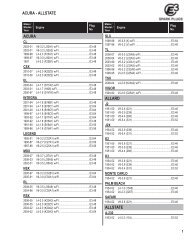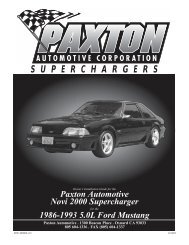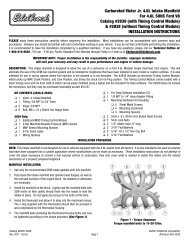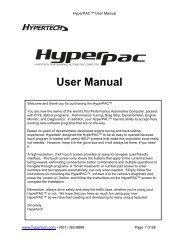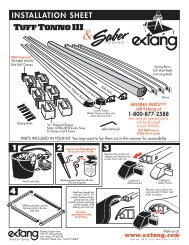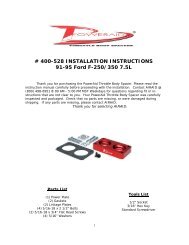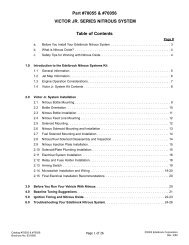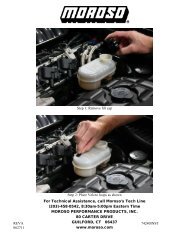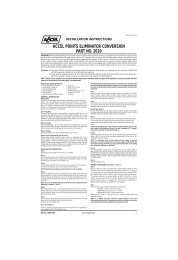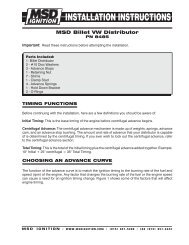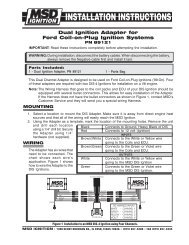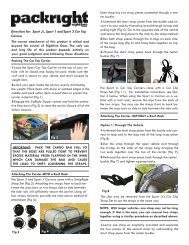NOS 05040 Nitrous System Installation Instructions - Jegs
NOS 05040 Nitrous System Installation Instructions - Jegs
NOS 05040 Nitrous System Installation Instructions - Jegs
You also want an ePaper? Increase the reach of your titles
YUMPU automatically turns print PDFs into web optimized ePapers that Google loves.
3. Start the engine.<br />
4. Turn the arming switch on. Set the engine speed at 2000 RPM. Briefly depress the activation arm on the microswitch.<br />
Engine speed should decrease if the fuel delivery system is performing properly; if not, refer to Appendix A, Troubleshooting<br />
Guide.<br />
5. Open the nitrous bottle valve.<br />
NOTE: There should be no change in the engine idle speed. If the idle speed changes, refer to Appendix A, Troubleshooting<br />
Guide.<br />
6. Inspect the nitrous lines and fittings for leaks.<br />
7. ENJOY!<br />
Chapter 5 Advanced Tuning for Maximum Power<br />
5.1 Optimum <strong>Nitrous</strong>/Fuel Jetting<br />
After performing the Baseline Tuning Suggestion—Chapter 3, if you desire to maximize the performance of your system,<br />
perform the following:<br />
NOTE: Always perform the nitrous/fuel jetting modifications listed in Section 5.1.1 before attempting to optimize the ignition<br />
timing (Section 5.1.2). Improper nitrous/fuel jetting can mislead you when attempting to optimize the ignition timing.<br />
5.1.1 Determining Optimum <strong>Nitrous</strong>/Fuel Jetting<br />
NOTE: The procedure outlined in this section is not recommended for Kits 05030-FI<strong>NOS</strong> & <strong>05040</strong>-FI<strong>NOS</strong>, unless you are<br />
operating at fuel pressures outside the design envelope (35-45 psi) of the system.<br />
The jetting combinations included in Kits 05030<strong>NOS</strong> & <strong>05040</strong><strong>NOS</strong> are intended to provide you with a safe, reliable power<br />
increase. They are intended to be used with 900 psi nitrous bottle pressure and 5-6 psi flowing fuel pressure. In some<br />
instances, installing slightly smaller fuel jets than the units provided in your kit, will provide a more optimum nitrous/fuel ratio and<br />
increase power.<br />
Always run the baseline jetting included in your kit before attempting to decrease fuel jet size. Optimum jetting can be<br />
determined using the following scheme.<br />
1. Stabilize the nitrous bottle pressure at 900 psi.<br />
2. Perform a dynamometer pull or a full throttle pass down the racetrack. Note the power reading or vehicle mph (not e.t.).<br />
Examine spark plugs for the indication of lean or rich nitrous/fuel conditions (refer to Figure 18 for tips on reading the spark<br />
plugs).<br />
2A. If spark plugs appear to be excessively rich, decrease the fuel jet size 2 steps (ex. 22 to 20, 20 to 18, etc;).<br />
2B. If spark plugs appear to be excessively lean, increase the fuel jet size 2 steps.<br />
2C. If spark plugs have a “like new” appearance on the porcelain and electrode, do not make a fuel jetting change.<br />
3. Repeat steps 1 and 2 until the desired mixture is obtained.<br />
Figure 18 Spark Plug Condition<br />
23



